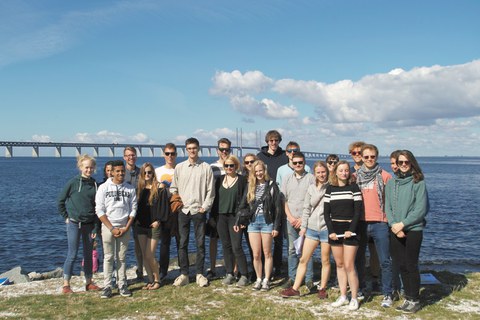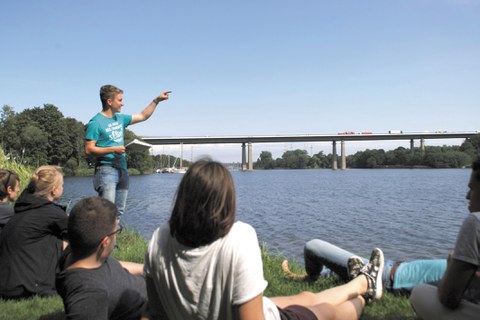Bridge excursion 2017 - Bridge diversity around the Baltic Sea

Excursion participants 2017 before the Öresund crossing
This year's bridge excursion headed north. The concept of starting the trip with minibuses and camping at campsites at low cost was maintained. As in the previous year, the excursion was fully booked with 25 participants. The accompanying students were actively involved in the program as well as in the realization of the excursion.
The start was on Thursday, 10.8.2017, immediately following the examination period of the summer semester. The first destination was Berlin, where we first visited the Sonnenallee junction of the BAB A100 beltway and were shown the expansion using the open tunnel construction method. We then headed for the construction project for the S21 urban rail line at Berlin's main train station. We also visited the station concourse and the Humboldthafen Bridge. In the evening, we moved to the first campsite north of Berlin, and from there to the replacement bridge at Petersdorfer See the next morning. In the afternoon we visited the Rügen bridge on the Baltic coast. After a night on Rügen, we took a "close look" at the pedestrian bridge in the city harbor of Sassnitz before transferring by ferry to Trelleborg in southern Sweden on Saturday afternoon. After this first leg, we explored the southern Swedish city of Malmö on Sunday afternoon. On Monday morning we rested and continued with the second stage and a tight program. First, we visited the Öresund Bridge, an impressive experience for the students, and in the afternoon we experienced the explanations on the expansion of the metro in Copenhagen, Denmark. Once again, we were able to learn about the interfaces between special civil engineering and bridge construction. The evening city tour of Copenhagen took us, among other things, to movable bridges such as the Butterfly Bridge. On Tuesday, we crossed Denmark, with the bridges on the Great and Little Belt not missing from the excursion program. Spans of over 1600 m are not an everyday experience for both the students and the supervisors.
We marveled at the special steel construction of the Rendsburg High Bridge during a guided tour, after we had previously been informed about the deficits of the Rader High Bridge (BAB A7) during a student presentation.

Student lecture at the Rader high bridge
We spent the rainy night in Schleswig-Holstein in order to visit the construction measures around the BAB A7 in Hamburg the next morning. In addition to the Stellinger Deckel, an under-tunnelled passage of the BAB A7, we also visited the bridge construction site for the new Langenfelder Brücke. The information on the demolition and new construction of the steel composite superstructure met with great interest among the students. Everyone also enjoyed the subsequent evening program in downtown Hamburg, which included a guided tour of a brewery. After a week, the participants' thirst for knowledge continued unabated, with the Kattwyk lift bridge and the bascule bridge, two exceptionally large movable bridges, on the agenda. The week was rounded off with a visit to the widening of the A14 freeway near Güstrow. In addition to a semi-integral steel composite structure, we were able to inspect a game bridge in solid construction. On Friday, 18.8.2017, we reached Dresden again towards evening.
We were very pleased with the consistently positive feedback from the students. Special thanks go to our contact persons on site, who took a lot of time for the tours and questions, and to our financial supporters. We would be happy to organize another bridge excursion next year and thus provide the students with a unique experience during their studies.
Oliver Steinbock and Sebastian May
